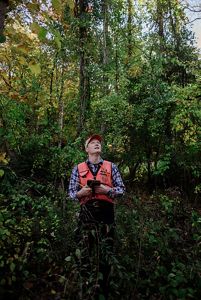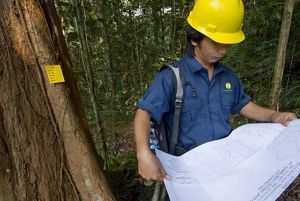Natural Climate Solutions
Natural climate solutions offer immediate and cost-effective ways to tackle the climate crisis—while also supporting healthy, thriving communities and ecosystems.

Carbon monitoring Measuring the circumference of a tree trunk as part of carbon monitoring in a forest in Indonesia’s Berua District. © Bridget Besaw © Bridget Besaw
Around the world since time immemorial, people have depended on trees for their livelihoods and survival. When communities live in harmony with them, forests can provide clean water and air, a sustainable source of timber and jobs, and a gateway to outdoor tourism and recreation. They make communities more resilient to extreme heat and severe floods and give wildlife a place to live and roam. Importantly, forests can also help us slow down climate change by storing carbon in their roots, trunks and leaves.
Climate-smart forestry (CSF) is a way of managing forests that helps them stay resilient in a changing climate, store more carbon from the atmosphere, and support the people and wildlife that rely on them.
Around the world, climate-smart forestry (or improved forest management) might look different depending on where the forest is and how nearby communities depend on it. When it’s informed by on-the-ground science and includes the appropriate stakeholders and rightsholders, climate-smart forestry can boost resilience, biodiversity and economies.






Cururu, Bolivia: A Bolivian forester measures a tree trunk as part of the sustainable logging process. © Ami Vitale

Democratic Republic of Congo: TNC staff and forest technicians measure the amount of hollowness at the center of a log, part of a climate-smart forestry system called Reduced Impact Logging for Climate. © Peter Ellis/TNC

Berlin, New York: A forester assesses a forest for the Family Forest Carbon Program, which pays landowners for implementing climate-smart forestry practices. © ULLMANPHOTO.com 2024

Borneo, Indonesia: A forester studies a map in a sustainably managed logging concession. © Bridget Besaw

Quitana Roo, México. : By using a portable sawmill to cut planks of wood out of the trees they harvest, community members can carry the planks of wood out of the forest with minimal impact. © Erika Nortemann/TNC
Here are some (but not all) of the places TNC works on climate-smart forestry around the world.
No results are shown. To see results, turn on the toggle switches in the legend.
To prevent further forest loss, The Nature Conservancy and our partners established the Africa Forest Carbon Catalyst (AFCC), an incubator designed to accelerate the growth of promising carbon projects by supporting them through the complex and costly stages of development and verification to reach the goal of selling carbon offset credits.
TNC and partners researched how selectively cutting the liana (woody vines) from trees can improve the health of managed forests around the world—and help mitigate climate change.
Research shows that selectively logged tropical forests can retain up to 80% to 100% of native flora and fauna species, if managed very carefully and logged at a low intensity. If this rate holds true in Berau, then retaining land in logging concessions, instead of converting to oil palm or fiber plantations, could be a major player in conservation.
Many Indigenous communities already manage forests in ways that draw from their traditions and values. In many cases, these practices are sequestering more carbon and resulting in improved economic outcomes for communities. Our Canadian affiliate, Nature United, works alongside local communities to support Indigenous-led forest management in British Columbia.
In Southern China, we provide technical assistance to local forest managers and support local authorities in developing and implementing climate-smart forest management plans. TNC also supports forest policy goals by using the best available science to inform China's NDC goals, which heavily emphasize forests as a key ecosystem to combat climate change.
The Congo Basin is the world’s largest carbon sink. TNC is working with local partners including communities, concessions, environmental non-profits and governments in this region to pilot and scale lower-impact forestry methods through RIL-C, which can have a significant impact on global climate and biodiversity outcomes while maintaining positive impacts on local economies.
Cumberland Forest Project spans 253,000 acres in Kentucky, Tennessee and Virginia, in one of the most important areas for climate resiliency in North America. TNC seeks to support local economies through sustainable timber harvesting that utilizes local loggers and mills. A recreational leasing program will provide access for wildlife viewing, fishing, hunting and other activities.
TNC in Ecuador is supporting a project that encompasses 117,000 hectares of managed lands belonging to the Kichwa and Shuar Indigenous nationalities in the Napo and Pastaza provinces of the Ecuadorian Amazon.
The Family Forest Carbon Program, a program created by the American Forest Foundation and The Nature Conservancy, supports family forest owners in improving forest health and addressing climate change through practices like selective thinning and gap harvesting.
TNC has been working with local ejido communities and other partners in this region for more than 10 years to implement Reduced Impact Logging for Climate (RIL-C).
In Michigan's upper peninsula, TNC promotes sustainable forestry practices, such as selective logging, which involves assessing each individual tree to decide which trees should be cut for the health and diversity of the whole forest.
TNC uses and shares climate-smart forestry practices in the Northwoods of Minnesota that increase the forest's carbon sequestration and storage potential. Tactics include planting climate-resilient species and performing selective harvesting guided by climate science to promote resilient forests.
TNC is working with the local government in Solomon Islands to complete a feasibility study for a pilot climate-smart forestry project in Barora Fa with plans to scope across the province for other carbon opportunities.
A collaborative conservation effort saved one of the world’s last large swathes of temperate rainforest, avoided the release of more than 500,000 tons of carbon emissions, created a conservation-focused local economy complete with new jobs and opportunities and protected one of the oldest trees on Earth.
Forests are critical for biodiversity. They provide habitat for 80% of the planet's land-dwelling species.
Forests support the livelihoods of 1.6 billion people worldwide through food, fuel, medicine, shelter and income, particularly among rural and Indigenous communities.
According to the latest research, climate-smart forestry practices implemented around the world could mitigate 490 megatonnes of CO2e annually.
As a conservation organization grounded in science and partnership, we focus on projects with the most positive outcomes for climate mitigation, biodiversity, and people. TNC has a long history of working in regions where these goals intersect—for example, the Congo Basin, the Amazon Basin, Indonesia and North America—and for over 70 years we have led cutting-edge research that’s driving new innovations and best practices in climate-smart forestry around the world.
TNC's work in climate-smart forestry focuses on these three strategic pillars:
Results show how leakage varies by CSF activity, location, forest type, timeframe, and implementation rate. Download the study
This methodology applies to a wide range of improved forest management (IFM) practices and uses dynamic performance benchmark for additionally and the crediting baseline created from national forest inventories. Read about the methodology
Using what is referred to as a “dynamic baseline,” we compare the carbon sequestered on lands enrolled in the Family Forest Carbon Program to highly similar forests that are not enrolled in the program. Read about the program.
An overview of Reduced Impact Logging for Climate Change Mitigation. Download
A free, online course designed to equip you with the knowledge needed to implement effective NCS. Enroll in the course
Climate-smart forestry can help solve climate change, but not on its own. Though it is an effective, affordable option for carbon storage, climate-smart forestry and other natural climate solutions must be paired with phasing out fossil fuels and accelerating renewable energy.
In some cases, healthy forests can be left alone to grow and thrive without management. But many forests have been historically mismanaged. Clear cutting an entire forest, ignoring natural fire cycles, planting monoculture plantations, slash-and-burn agriculture, and similar activities leave forests degraded and vulnerable. In these cases, restoring or maintaining a forest’s health requires sustainable practices that balance human needs with ecological resilience.
TNC is intentional about climate-smart forestry. We design these projects based on the specific needs and challenges of a place in partnership with the people who live there.
Climate-smart forestry includes a wide range of practices, which may or may not involve cutting down fewer trees.
For example:
TNC does not support unchecked, destructive logging. We advocate for sustainable forest management practices based on sound science and traditional knowledge. Sometimes this includes cutting down trees.
A growing body of scientific research confirms that while poor and indiscriminate logging practices can harm forests and the people who depend on them, carefully planned and sustainable forest management makes it possible for nature, communities and economies to thrive.
Many of the world’s natural forests provide wood and fiber products—like lumber, furniture and paper—are critical to people’s lives and livelihoods. While some logging practices harm forests and the people that depend on them, improved and sustainable forest management makes it possible for nature, communities and economies to thrive.
Climate-smart forestry has many benefits for people and nature beyond climate mitigation. It can save costs by making timber harvests as efficient as possible, enhancing sustainable timber production, and creating jobs related to monitoring. Healthy, well-managed forests protect biodiversity, provide clean water by filtering and regulating supplies, and strengthen resilience against wildfires, pests, and extreme weather.
To learn more about climate-smart forestry and other forest-based climate solutions, explore TNC’s free, online NCS curriculum.
Access the latest reports, tools & in-depth thinking on real-world solutions to climate change, water security, biodiversity and human health.

Science shows that—combined with cutting fossil-fuel use and accelerating renewable energy—natural climate solutions can help us avoid the worst impacts of climate change.